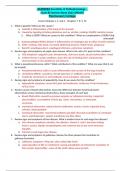NUR2063 Essentials of Pathophysiology –
Exam #2 Review Sheet 2022 UPDATE
Rasmussen College
Covers Modules 4, 5, and 6 – Chapters 7, 8, 9, 10
1.What is gastritis? What are the causes?
a.Gastritis is inflammation of the lining of the stomach
b.Caused by ingesting irritating substances such as alcohol, smoking, NSAIDS, bacteria/viruses
2.What is GERD? What are causes to this condition? What are complications of GERD if left
untreated?
a.Gastroesophageal Reflux Disease is inflammation of esophagus due to reflux of acidic material
b.EtOH, smoking, fatty foods, increased abdominal pressure, hiatal hernia, pregnancy
c.Barrett’s esophagus,ulcers, esophageal strictures, pulmonary symptoms
3.Review signs and symptoms of peptic ulcer disease. What is the role of H. pylori in this condition?
a.PUD symptoms: epigastric pain, hematemesis, dark tarry stools, ab pain before/after a meal
b.H.Pylori thrives in acidic conditions, slows the rate of healing ulcers and promotes ulcer formation in the duodenum and stomach.
4.What is pseudomembranous colitis? What contributes to this condition? What are ways that it can be treated?
a.Pseudomembranous colitis is acute inflammation and necrosis of the large intestine
b.clostridium difficile- caused by a broad spectrum of antibiotic use for a long time
c.treated by vancomycin or metronidazole, fecal transplant, colectomy
5.Review signs and symptoms of appendicitis. How do we assess for this condition?
a.Appendicitis symptoms: severe RLQ pain and tenderness, McBurney’s Point tenderness, N/V/D, fever
6.Review causes of bowel obstructions. Know the difference between functional bowel obstructions versus mechanical obstructions. Know examples of each type
a.Bowel Obstruction caused by previous surgeries w/ adhesions/scarring, congenital abnormalities, accumulation of fluid, gas, water, electrolytes, or metastatic carcinoma
b.mechanical obstruction- physical barrier (adhesions, tumors, hernia, impacted feces, volvulus, intussusception
c.functional obstruction- movement problems (paralytic ileus due to problems w/ peristalsis due to anticholinergics, opioids, anesthesia, low fiber diets)
7.Review signs and symptoms of liver disease. What is another term for end-stage liver disease?
a.Liver disease symptoms: jaundice, low albumin, vitamin D, and K, decrease clotting factors, ascites, hepatic encephalopathy and confusion due to too much ammonia, hepatitis,
b.Cirrhosis is end stages liver disease.
8.Review signs and symptoms of gallstones. Review the three phases that contribute to gallstone formation
a.Gallstones symptoms- RUQ pain, after eating fatty foods
b.supersaturation of bile w/ cholesterol causing precipitation of cholesterol; nucleation of bile crystals; hypomotility - stasis of bile which allows stone growth 9.Review signs and symptoms of pancreatitis. What are some causes to this condition?
a.Pancreatitis symptoms: constant boring pain in LUQ and epigastric pain that radiates to the back, N/V, low grade fever
b.caused by EtOH, medications, trauma
10.What are the function of the kidneys? How do we assess for renal disorders?




